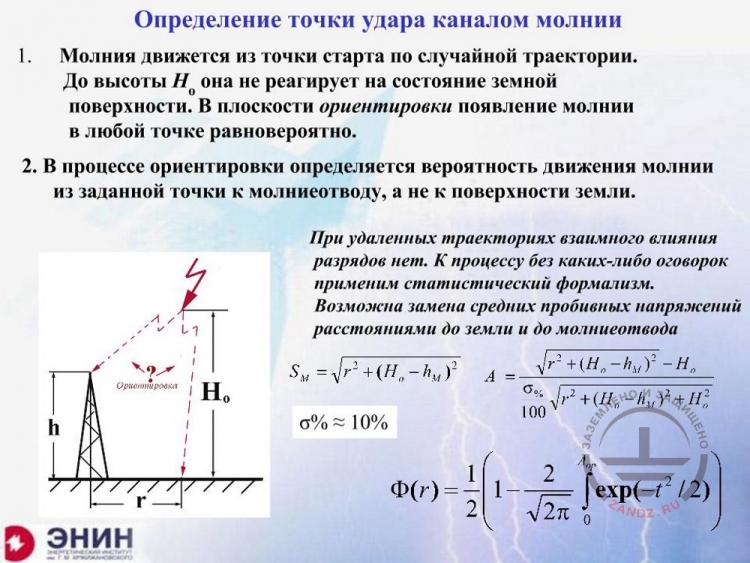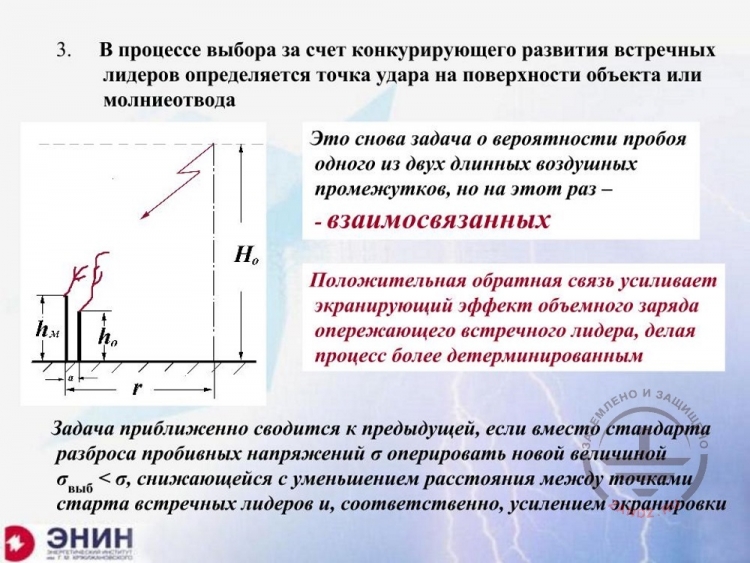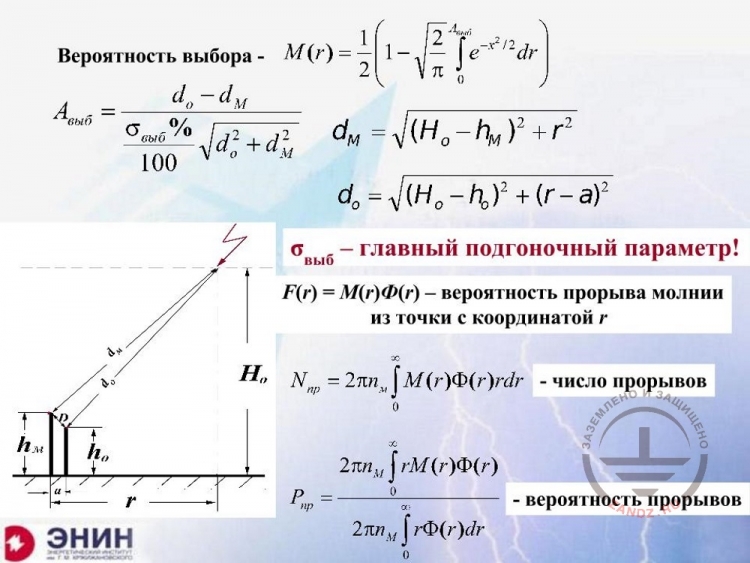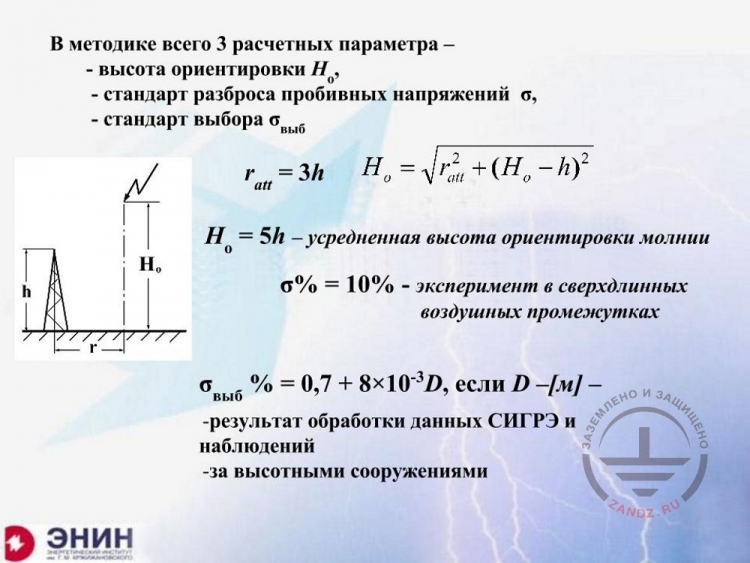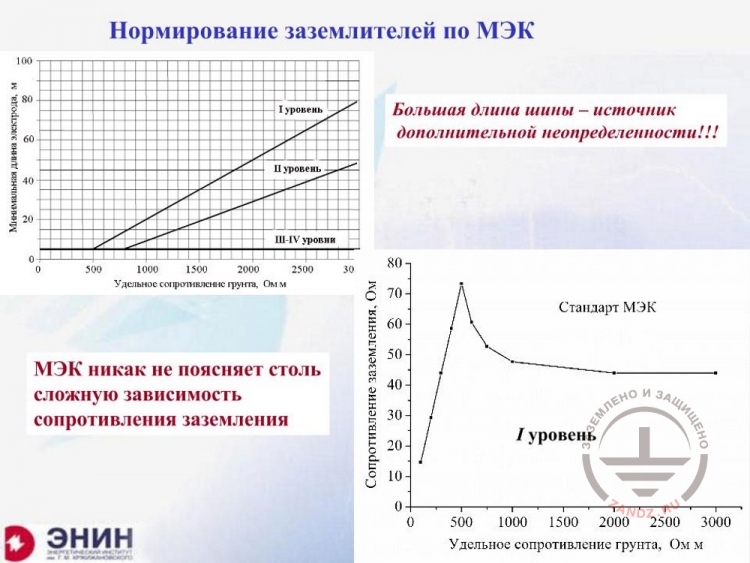The tenth webinar of a series "Grounding and lightning protection: issues and problems arising in the design"
Webinar text. Page 3
Quick navigation through slides:
<< Page 1:
1. How to choose lightning rods after all
2. Regulatory framework
3. Questions for EIC experts. Part 1.
4. Questions to IEC experts Part 2.
5. Number of lightning strikes
6. IEC protection angles method
7. Experiment image
Determination of the strike point by the lightning channel. Part 1
Определение точки удара каналом молнии – Determination of the strike point by the lightning channel
- Молния движется из точки старта по случайной траектории. До высоты Но она не реагирует на состояние земной поверхности. В плоскости ориентировки появление молнии в любой точке равновероятно - Lightning moves from the start point on the random trajectory. Up to height Ho it doesn’t react on the condition of the ground surface. Appearing of lightning is equally probably in the orientation flat.
- В процессе ориентировки определяется вероятность движения молнии из заданной точки к молниеотводу, а не к поверхности земли - In the process of orientation, the probability of lightning movement from the fixed point to the lightning rod, not to the ground surface, is determined.
При удаленных траекториях взаимного влияния разрядов нет. К процессу без каких-либо оговорок применим статистический формализм - At the remote trajectories of mutual influence, there are no discharges. Statistical formalism is applied to the process without any stipulations.
Возможна замена средних пробивных напряжений расстояниями до земли и до молниеотвода - The change of average puncture voltages by the distances to the ground and lightning rod is possible.
— It was resolved with physical simplifications. I am not telling you to use this theory in your practical activity, but so you understand, basing on the Soviet and Russian regulations and after Russia became a legal successor of the Soviet Union. We are talking about the following. Lightning develops regardless of the thunder cloud, not reacting on the condition of ground surface and because this condition is too far. Starting from some height, lightning reacts what way is closer to it - to the ground or to the lightning rod. And these events can be calculated using the formal probability theory. This way it is possible to determine where lightning goes. To the ground or to the lightning rod - object? And then the second step.
Determination of the strike point by the lightning channel. Part 2
-
В процессе выбора за счет конкурирующего развития встречных лидеров определяется точка удара на поверхности объекта или молниеотвода - In the process of choice, the strike point on the surface of the object or lightning rod is determined at the expense of the competing development of counter leaders
Это снова задача о вероятности пробоя одного из двух длинных воздушных промежутков, но на этот раз – взаимосвязанных - It is again the task about the probability of a puncture of one out of two long air gaps, but this time – interconnected ones.
Положительная обратная связь усиливает экранирующий эффект объемного заряда опережающего встречного лидера, делая процесс более детерминированным - Positive reaction coupling enhances the shielding effect of the spatial charge of the advanced counter leader, making the process more determined.
Задача приближенно сводится к предыдущей, если вместо стандарта разброса пробивных напряжений ….. оперировать новой величиной….., снижающейся с уменьшением расстояния между точками старта встречных лидеров и, соответственно, усилием экранировки - The task is approximately brought down to the previous one, if to operate with a new value instead of the standard of puncture voltages scatter, which reduces with the reduction of distance between the start points of counter leaders and enhancing of shielding correspondingly.
— And this dependence is much more determined, because, developing from a lightning rod and the object, the charges influence each other. The advance charge is supressing the one lagging behind by its electrical field. It was shown in the form of a calculation mode like I am telling you. And on the base of this calculation model, all these protection zones which you use in design practice were built. Where were the adjustable parameters in this calculation model? In this calculation model, in fact one single value was an adjustable parameter. It is a value-standard, which defines the scatter of counter charges development between the lightning rod and object. It was necessary to extract this standard from real data. And we extracted it out of real data, the main of which was statistics of lightning strikes on overhead power lines. This statistics counts millions of events. It is reliable to a sufficient extent and using this statistics we built a method on which the protection zones, which are present in the authorizing documents AD-34 and IS-153, are made.
Choice probability
Вероятность выбора – choice probability
Главный подгоночный параметр – the main adjustable parameter
Вероятность прорыва молнии из точки с координатой r – probability of lightning breakthrough from the point with r coordinate
Число прорывов – number of breakthroughs
Вероятность прорывов – probability of breakthroughs
— We stick to this statistics due to one reason - it is impossible to make anything more perfect basing on the use experience we have today. But what is done now and is included into the Russian standards is justified by the great use experience. And I want to tell you one more thing now.
Calculation parameters of methods
В методике всего 3 расчетных параметра - There are 3 calculation parameters-
- высота ориентировки Но- orientation height Ho
- стандарт разброса пробивных напряжений…- - standard of puncture voltage scatter…
- стандарт выбора … - …choice standard
- Ho= 5h – усредненная высота ориентировки молнии - Ho= 5h – average height of lightning orientation
- ……10% - эксперимент в сверхдлинных воздушных промежутках - experiment in superlong air gaps
- - результат обработки данных СИГРЭ и наблюдений - result of processing CIGRE data and observations
- - за высотными сооружениям - high-rise structures
— What can this method give? What is its disadvantage at the moment, because nobody in the world has an ideal calculation method.
Standardization of ground electrodes according to IEC
Нормирование заземлителей по МЭК - Standardization of ground electrodes according to IEC
Минимальная длина электрода, м – Electrode minimal length, m
Уровень I – Level I
Уровень II – Level II
Уровень III – Level III
Удельное сопротивление грунта, Ом*м- Ground resistivity, Ohm*m
Большая длина шины – источник дополнительной неопределенности! – Large bus length is the source of additional uncertainty!
МЭК никак не поясняет столь сложную зависимость сопротивления заземления – IEC doesn’t explain the complex dependence of grounding resistance
Сопротивление заземления, Ом – Grounding resistance, Ohm
Стандарт МЭК - IEC standard
— First about the weak points of this method. I told you that we are using the experience of using overhead power lines. It fits to test the calculation method on the level of reliability say, 0,999. And we don't have enough data to move on and try to catch another nine. There is no ground to operate with reliability greater than 0,999. Though formally, this method allows that, but the figure you get is tested only approximately to the level of 0,999. If I want a greater reliability, I will falter. There is another point which is not discussed by IEC.
— Thank you, Eduard Meerovich! We had a question from Dmitry. Is the reliability higher than 0,999 necessary?
— For an ordinary urban planning, the reliability more than 0,999 is not necessary. But for unique objects, for example for such as newly built complexes – spaceport in the Far East. Imagine such a situation. Complex in the Far East is not very different from Baikonur. A thunderstorm in Baikonur is an extraordinary situation. A thunderstorm in the Far East is an ordinary situation. And if you protect the space launching base with the reliability of 0,999 it won't necessarily mean that the specialists on spatial technical equipment will be satisfied. They might require higher reliability. It also refers to the reliability of flying vehicles. Even aviation. Or to the reliability of warehouses of explosives. Or to the reliability of storing objects of weaponry or communication. The reliabilities higher than 0,999 can exist there. But we can provide this figure formally. And it is impossible to prove that we provided, because nobody has this data now.
— Thank you for the answer, Eduard Meerovich. We have two more questions. The second question from Anton:" Why it is prohibited to put mesh on a roof with a pitch more than 1:8. Will it protect from anything?" »
— I understood everything, thank you very much. You should have asked the compliers of the standard about pitch, because they put this mesh into our regulatory document. I've said today and at the past seminars and I will repeat it again, that any mesh put on the roof at any pitch, even zero, doesn't possess protective action. Because it doesn't elevate above the surface to be protected. If you raise the mesh above the roof, then it will present itself a system of catenary wire lightning rods. And these catenary wires will work. And they will start to work more efficiently the higher the mesh is raised. In fact, the operation of the mesh starts with the moment, when it elevates above the roof to one meter and more. And with the software I mentioned, you could calculate the reliability of the mesh operation depending on its elevation above the roof. It is a complete absurd to use the same mesh laid on reinforced concrete slabs of our typical roof. And the only thing why it is needed, is on one hand to satisfy the requirements of GosTekhNadzor, which won't put this building in commission.
— The next question from Ilya, it's long. Let me read:" It is only said about collective action of lightning rods in AD 153-34.21.122. IS 153 excludes the method of calculating multiple lightning rods. Does it tell about ambiguity of calculation method in AD, about which you mentioned, or multiple lightning rods...»
— Aleksey, thank you! That's a very good question. The bad thing in IS-153 is that this document was not finished. When it had been made, the collective of authors were promised that as soon as they make the outline of this authorising document, and this outline will be approved by the Ministry of Energy, the specialists will get funding, and they would be able to make software applicable for the calculation of any number of lightning rods of any structure. We still have this bananas oil because we received no funding at all. And IS 153 has the following item. If there are more than two lightning rods and they are of different height and different type, they have to be calculated using software. But commercial software was not implemented. Why I've mentioned the project "Grounding and lightning protection on ZANDZ.com". Not because this seminar is held at their expense, but because the project "Grounding and lightning protection on ZANDZ.com" wants to make a commercial product. And this commercial product will appear soon. With its help it will be possible to count any combination of lightning rods of any height, any number and any type. You can, for example, calculate a combination of catenary wire and rod lightning rods. It is absolutely real today. This question is very correct and very timely, to my mind.
— Is a breakthrough between the object and a free standing lighting rod possible at a lightning strike, it the object is not metal? And what consequences may appear for the object at a lightning strike into the roof, if the roof is metal 0,2-0,3 mm thick and under the metal there are wooden beams?
— There are two questions here. And they are not interconnected. Can there be a breakthrough of the interval from lightning into a non-metal object. I am advised that there can't be a breakthrough, but I can't imagine a non-metal object. Imagine a wooden house. It is a non-metal object.
Now here's the second question. Your roof is, say, made of metal tiles of minor thickness, somewhere at the level of 0,5 mm. There is a lightning rod on this building. Lightning strikes into this lightning rod. What will happen to metal tile in this case, and more important, what will happen to wooden frame which is under the tiles? In this case, nothing will happen, because the frame won't be on fire. Lightning current will run along the lightning rod. Then it will go along the down conductor, which should be done from this lightning rod. Of course, part of this current will get into the tile. But even if it is a large portion of current, this metal tile won't melt in this case and there will be no ignition. Moreover, the situation, which the colleague posed in the form of the question, is a typical situation. If your house is made of metal tiles and you worry about its security, because the whole roof has wooden frame, you have to do so as it is asked in this question.
— Will there be fire? Which variant of lightning protection if more preferable at such a structure of the roof, to your mind?
— I would say, many variants are possible here. If you have a house with metal tiles, the thinnest layer of metal, then I recommend to run a catenary wire along the roof ride at the height of 1,5-2 meters. What will it provide in this situation? It will provide reliability somewhere at the level of 0,9. What does reliability of 0,9 mean? Let's discuss. For instance, we are talking about a wooden cottage, and say, at the level of 10 meters one lightning strike will hit this house once in 30 years. At the reliability of 0,9, you will have to wait 300 years until a lightning breaks through your catenary wire to the wooden frame. 300 years is quite a decent time period even from the position of English aristocracy. I am advising you to make such lightning protection.
— Does metal roofing provide electrical continuity and is it possible to use roofing as a natural lightning rod?
— I can answer this question strictly in accordance with IS-153, which says about the following. If your roof is made of profiled metal or metal tiles. And you know that tiles have decorative insulation layers and anti-thunderstorm insulation layers. If these layers are thicker than one mm, then you can think that this roofing is interconnected by metal, because a millimetre layer for the potentials which lightning will create, doesn't present any obstacle at all. It is necessary to ground this roofing with the help of special clamps, which are put the grounding roofing on the bus and fasten it. Of course it is impossible to weld the roofing 0,5 mm thick. And metal tiles of such a type are sold by many companies, native as well. It would be best of all, if this roofing is grounded in two places, for example, to those thermal ground electrodes which are indicated in AD-34. They are quite applicable for the aim, you want to achieve. But there is one serious thing to mention. The most dangerous thing why your house can be put on fire, is if you make a short circuit in the 220 V circuit, which you get, because the insulation inside the circuit of 220 V is counted for the voltage of 2,5 kV only. And if we don't have SPDs, which will protect from short circuit, you will make a fire because the ground potential of a non-zero wire will skyrocket, when the lightning current will be spreading over your ground electrode and there will be a short circuit on the phase bus 220 V or 380 V, depending on your power supply system.
— Thank you, Eduard Meerovich. Should you have any other questions, feel free to send it to our email. We will do our best to answer them. I will write the email address in the chat. A long question from Denis. Will you read it yourself or shall I?
— I will read. Question: "Rod lightning rod 10-12 meters high is mounted on a concrete site of a gas station".
I can't answer this question for one simple reason. In order to understand if such a lightning rod is good or not good, we need to have geometric sizes to see if all the rest area and buildings of this gas station fit the protection zone of the rod. And we also should see how the current from this lightning rod is diverted? Because, there should be underground reservoirs with fuel and we need to study this matter absolutely specifically. Unfortunately, I can't answer this question now without geometric sizes.
— Eduard Meerovich, Denis precises that the site is 6x4 meters.
— What is the object height? At what distance the air terminal is put. Unfortunately, I can't answer this question now without paper and a calculator. If you send it to me in a written form with all the necessary details, I will answer it with pleasure.
— We can do it this way, Denis will send us the question with the object description, we will find an answer for him.
— By all means! In any case, the ground electrode will probably contradict the authorizing documents, I can tell you at once. But I would like to get this reply in a written form with precise sizes. For sure, we can answer this question at the seminar with all the questions.
— OK. All these answers will be published on our site, so you can visit it and see. We can switch to the second question: "Grounding contour - is a metal plate 4 cm wide and 4 mm thick. It is buried around the perimeter from the site at the distance of 1-1,5 m, 30-40 cm deep. Metal rods 2 meters long are hammered in a meter and are welded to the plate. Grounding contour is connected to the container filling station, so the grounding would function. Concrete base one meter wider and longer than the installation itself. Does it contradict the authorizing documents?»
— It won't contradict lightning protection documents. But I can't answer if it contradicts the requirements on the protection of objects with large volumes of hydrocarbon fuel.
It doesn't contradict lightning protection regulatory documents.
— Here a precision on the object is necessary and then we will be able to give a complete answer. Yes, we can do it. You can send us your question to our email address, which I've written in the chat, with the description of the object. If we need any additional information, we will ask it from you and then answer your question. If you have any questions which we can answer now, please, go ahead and ask.
— What’s there?
— I've been asked to send email address again. It is above the last comment - info@zandz.com.
— Then, dear colleagues, it was a pleasure to answer your questions. I tried to convince you as much as I could. It is better to orient the Russian standards until we get anything principally better. If you don't blow your own horn, no one will do it for you. But I think, the Russian standards are much better than the Europeans today. It concerns only external lightning protection, because in relation of internal one- nothing is good neither in the national, nor in the international standards. It is quite large; it is too early to say that what we recommend in Russia is the best thing. In relation of external lightning protection, there is no ground to avoid Russian standard. And thank you very much for your attention once again. Best Regards! See you soon!
— Eduard Meerovich, thank you very much for your wonderful report! Colleagues, you can find all video recordings of the webinars on our site, the link is in the chat now. Please visit and see all of them. Let me repeat, if you have questions about design or calculation of grounding and lightning protection, you can send them to our email address info@zandz.com. I will put it in the chat again. Write you questions there and we'll try to answer them all. Thank you for your participation! See you soon!
Do you have any questions left? Send them to our technicians and you will get detailed answers.
<< Previous Page
Slides 11 to 22
Useful materials for designers::
- Webinars with the leading industry experts
- Everything for the calculation of grounding and lightning protection
- Useful materials: articles, recommendations, examples
Related Articles:
 6. How to do that?
6. How to do that?


